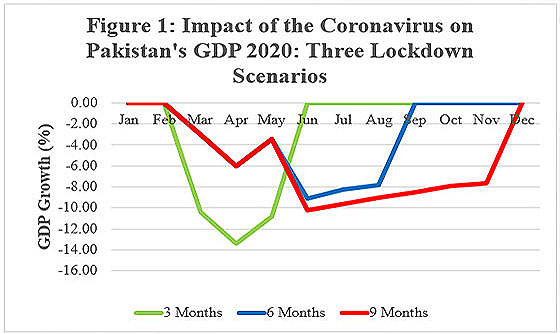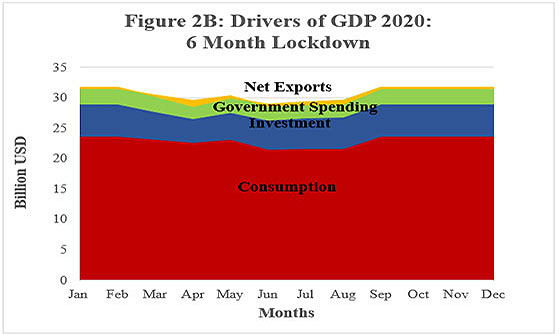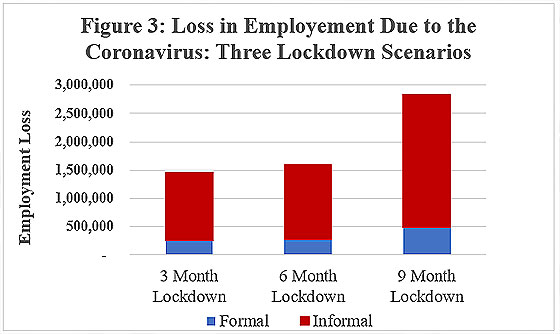 | Department of Economics |
| NEWS & MEDIA |
MEDIA
Estimates of the impact of the Coronavirus Pandemic on Pakistan’s
Economy – 6 May 2020
Moazam Mahmood, Azam Chaudhry, Aimal Tanvir, Muaz Chaudhry
Lahore School of Economics Modelling Lab
Innovation and Technology Centre
Lahore School of Economics
Estimates
We have estimated the impact of the Coronavirus pandemic on Pakistan’s GDP and employment. Using a General Equilibrium Macro (GEM) model for the Pakistan economy that the Modelling Lab Team at the Lahore School’s Innovation and Technology Centre has developed over the past two years for policy simulations and teaching. These GEM forecasts are usually made for the Annual Conference on the Management of Pakistan’s Economy. But the pandemic has intervened and needs to be assessed urgently for policy response. To enable policy discussion and options for decision making, we have made three alternative forecasts, based on three scenarios about the duration of the lockdown in Pakistan. A three month lockdown over March-April-May gives the relatively most optimistic impact on annual GDP growth and jobs for 2020. Given that at the time of running these simulations, on the 6th of May, the rate of infections appears to be spiking to over 1000 per day, and the Prime Minister very wisely urging caution in easing the lockdown, the three month scenario looks to be overly optimistic. Accordingly we have run separate scenarios for a six month lockdown, and as a longer run eventuality, a nine month lockdown. The lockdowns are assumed to gradually ease over the period of the lockdown. |
Our estimates show that as a result of the pandemic triggered lockdown, a three month lockdown, from March to May, will reduce Pakistan’s GDP by 2.9% for the calendar year of 2020. This will result in a job loss of 1.5 million by year end. Of this job loss, 1.2 million will be informal livelihoods lost, while 0.3 million will be formal jobs lost.
A six month lockdown, from March to August, will reduce Pakistan’s GDP by 3.1% for the calendar year of 2020. This will result in a job loss of 1.6 million by year end. Of this job loss, 1.3 million will be informal livelihoods lost, while 0.3 million will be formal jobs lost.
A nine month lockdown, from March to November, will reduce Pakistan’s GDP by 5.5% for the calendar year of 2020. This will result in a job loss of 2.8 million by year end. Of this job loss, 2.3 million will be informal livelihoods lost, while 0.5 million will be formal jobs lost.
Summary of methodology
This estimation exercise has been based on modelling first a supply shock to the economy, based on the lockdown of various sectors of the economy, and then a demand shock. The logic is that this crisis has unusually, compared to past economically triggered crises such as the Great Depression of the 1930s, the Asian Crisis of 1998, and the Financial Crisis of 2008, been triggered by a supply side shock. The lockdown of the non medical cum non essential sectors of the economies all over the globe, results in a supply shock. The supply shock gives a loss in income and output. This loss in income then results in a demand shock, primarily through reduced consumption and investment. So the full impact on the economy is a double whammy of both a supply shock plus a demand shock.
We have calibrated our GEM model for Pakistan’s economy, to capture this succession of a supply shock feeding in turn a demand shock.
We have estimated the supply shock based on an imputation of lockdowns in various sectors, based on GOP’s directives. The estimate is for the calendar year 2020. So the first two months give the baseline with no shocks. The lockdown began on 15 March. Thereafter the lockdown proceeds in full for the month of April, followed by a graduated winding down over the course of the lockdown for 2020. The three month lockdown is assumed to be over March to May. The six month lockdown is assumed to be over March to August. And the nine month lockdown is assumed to be over March to November.
These supply shocks triggered by the lockdowns, are then modelled to trigger in turn demand shocks. These demand shocks are primarily made to consumption, investment and imports – being domestic demand shocks. Exogenous demand shocks are made to exports, and remittances.
Which gives a cumulative reduction in GDP over 2020, of 2.9%, compared to 2019, for a three month lockdown. A 3.1% cumulative reduction in GDP over 2020, compared to 2019, for a six month lockdown. And an 5.5% cumulative reduction in GDP over 2020, compared to 2019, for a nine month lockdown.
It is worth noting that these estimate vary considerably from the IMF’s early estimate of a fall in GDP over 2020 of -1.5%. But are well in keeping with country estimates for instance in the Eurozone.
The model estimates that a three month lockdown with a loss in GDP of 2.9% results in a job loss of 1.5 million for 2020. A longer lockdown of six months with a loss in GDP of 3.1%, results in a job loss of 1.6 million. While a lock down of nine months, pretty much for the duration of the calendar year 2020, with a loss in GDP of 5.5%, results in a job loss of 2.8 million. The predominant job loss, is in informal livelihoods, at 1.2 million for a three month lockdown, 1.3 million for a six month lockdown, and 2.3 million for a nine month lockdown. This is in keeping with the ILO report estimating near 150 million informal jobs may be lost worldwide.
This is a first estimation made on 6 May 2020. Given that the trigger is the pandemic, its unfolding over time, and GOP’s responses to it can be expected to change the lockdown scenario. For which we will make periodic updates.







Annex
The supply and demand shocks are assumed to leave no permanent shut down of capacity across various affected sectors even at the end of December 2020. This is an optimistic expectation of no hysteresis. Hystersis is based on the argument that once a firm or small livelihood through self employment is shut, it is difficult to unshut it. This has not been modelled here
Link to the Article in the Express Tribune
 People
People